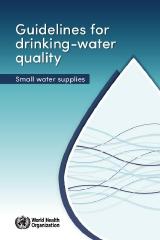Guidelines for drinking-water quality: small water supplies
 |
Directives sur la qualité de l'eau de boisson: petits approvisionnements en eau
guide Feb 2024 ; 220 pages
Ed. WHO - Genève ; Isbn: 978-92-4-008874-0
Téléchargeable sous format: PdF
Téléchargeable chez l'éditeur
Page de présentation d'un éditeur
 Sanitary inspection packages - a supporting tool for the Guidelines for drinking-water quality: small water supplies
Résumé:
Sanitary inspection packages - a supporting tool for the Guidelines for drinking-water quality: small water supplies
Résumé:Ces directives visent à fournir des orientations concernant l’application de cette recommandation aux petits approvisionnements en eau en particulier. Ces directives visent à aider les gouvernements et les praticiens à améliorer la sécurité sanitaire de l’eau de boisson fournie par de petits approvisionnements. Abstract:
These Guidelines, specifically tailored to small water supplies, build on over 60 years of guidance by the World Health Organization (WHO) on drinking-water quality and safety. They focus on establishing drinking-water quality regulations and standards that are health based and context appropriate; on proactively managing risks through water safety planning and sanitary inspections; and on carrying out independent surveillance. The guidance is intended primarily for decision-makers at national and subnational levels with responsibility for developing regulatory frameworks and support programmes related to these activities. Other stakeholders involved in water service provision will also benefit from the guidance in this document.
Designed to be practical and accessible, these Guidelines offer clear guidance that is rooted in the principle of progressive improvement. State-of-the-art recommendations and implementation guidance are provided, drawn from a comprehensive evidence review and established good practices. Additionally, case examples are provided from countries and areas around the world to demonstrate how the guidance in this publication has been implemented in practice in a wide variety of contexts. Contents:
Executive summary .xvi
1 Introduction and key concepts 1
1.1 Purpose, target audience, scope and structure.3
1.2 A typology of small water supplies.7
1.3 Guiding principles to achieve safe services from small water supplies . 9
2 Assessing the enabling environment 11
2.1 Guidelines recommendation.12
2.2 Rationale .12
2.3 Implementation guidance.13
2.3.1 Review service levels and trends .13
2.3.2 Review governance arrangements.15
2.3.3 Review financing.17
2.3.4 Review capacity and human resources .19
2.3.5 Review monitoring frameworks and practices.20
2.3.6 Develop a strategic plan to strengthen the enabling environment .21
3 Health-based regulations 23
3.1 Guidelines recommendations . 24
3.2 Rationale . 25
3.3 Implementation guidance. 26
3.3.1 Engage and support small water suppliers.26
3.3.2 Promote catchment-to-consumer risk management.28
3.3.3 Define priority water quality parameters .30
3.3.4 Set protective and realistic parameter limits.37
3.3.5 Establish monitoring frequencies and locations .38
3.3.6 Specify analytical requirements (including for field test kits).56
3.3.7 Establish reporting requirements and incident protocols.57
3.3.8 Define a risk-based surveillance programme.58
3.3.9 Establish suitable additional regulations .59
4 Water safety planning 63
4.1 Guidelines recommendation.64
4.2 Rationale .68
4.3 Implementation guidance.69
4.3.1 Understand the distinctions between risk management approaches . 69
4.3.2 Establish risk management requirements .70
4.3.3 Consider a staged approach to risk management requirements .73
4.3.4 Provide water suppliers training and guidance in risk management. 74
4.3.5 Provide water suppliers practical tools to support risk management.75
4.3.6 Establish sustainable financing for risk management programmes .76
4.3.7 Link to other WASH initiatives. 77
5 Surveillance 79
5.1 Guidelines recommendation.80
5.2 Rationale . 83
5.3 Implementation guidance. 83
5.3.1 Define minimum frequencies for surveillance activities.83
5.3.2 Progressively expand surveillance activities. 86
5.3.3 Invest in training and tools for surveillance staff. 88
5.3.4 Establish sustainable financing for surveillance. 90
5.3.5 Jointly analyse risk management scores and water quality.91
5.3.6 Share surveillance findings promptly and clearly.94
5.3.7 Strengthen surveillance-driven remedial action . 96
5.3.8 Address parameter exceedances. 98
6 Improving data use 101
6.1 Guidelines recommendation.102
6.2 Rationale .103
6.3 Implementation guidance. 104
6.3.1 Assess factors that contribute to effective data use .104
6.3.2 Progressively strengthen data use .107
6.3.3 Harmonize data collection and management.108
6.3.4 Prepare timely and fit-for-purpose reports.109
6.3.5 Systematize data use in decision-making processes .111
References.113
Selected further reading.117
Annex 1: Approach to content development and declarations of interest.121
Annex 2: Checklist of implementation actions to address Guidelines
recommendations.123
Annex 3: Case examples.125
Annex 4: Sanitary inspection packages.179
Mot clef: |
Editeur/Diffuseur: |
|
WHO
-
World Health Organization - Genève - Suisse |
En cas de lien brisé, nous le mentionner à communication@pseau.org